
WHICH MATERIALS ARE BEST FOR YOUR COOKWARE?
WHICH MATERIALS ARE BEST FOR YOUR COOKWARE?
Aluminum, steel, stainless steel, cast iron...Nowadays, cookware is made of several different materials. Each of these materials has its own strengths and characteristics. Some are more durable and resistant, others are easier to handle, and others are more reactive to heat. Sitram offers a wide variety of saucepans, frying pans,
Dutch ovens, pressure cookers, and specialty cookware done in premium materials to meet the needs of all consumers. So which materials should you choose for your cookware? What are the advantages of stainless steel, aluminum, or cast iron cookware? And why choose Sitram cookware?
The different materials offered
From stainless steel to aluminum, including cast iron and steel ... Focus on the main materials of cooking utensils.
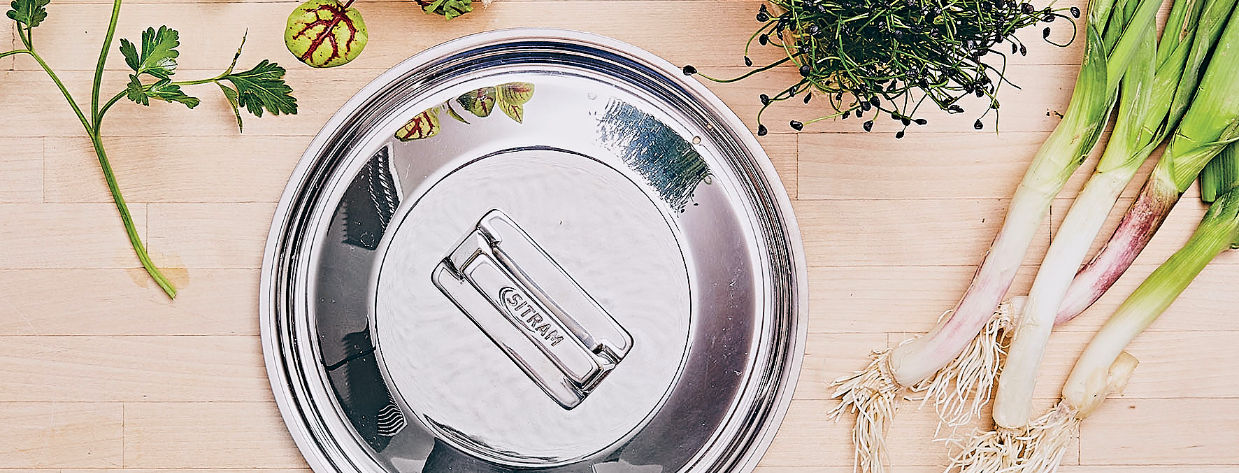
Stainless steel
Sitram's material of choice, stainless steel, is an alloy composed of nickel, steel, and chromium (very little carbon). Cookware and kitchen accessories can be made of 18/0 or 18/10 stainless steel (these numbers refer to the percentage of chromium and nickel contained in the material). Sitram specializes in this material, and more particularly in the use of premium 18/10 stainless steel.
Lightweight, robust, resistant to heat, and easy to clean, this high-performance material is (as its name suggests) rustproof: it therefore presents no risk to health and effectively preserves the flavor of cooked foods. It is also 100% recyclable.
Strong points
- Solid: stainless steel is resistant to heat and extreme differences in temperature. It does not warp or scratch.
- Durable: stainless steel does not corrode, deteriorate, or rust (as its name suggests, it does not stain).
- Easy to clean: stainless steel surfaces (both the inside and outside of your cookware) are easily cleaned by soaking them in water, even if burnt food is stuck to the bottom.
- Healthy: stainless steel is neutral and inert, and therefore poses no risks to your health.
- Cooking: uncoated stainless steel is perfect for safely searing meat, poultry, vegetables, and fish over high heat. Stainless steel cookware can be deglazed to obtain delicious cooking juices. It can also be used at lower temperatures to preserve the vitamins and minerals of foods.
Weak points
- Cooking: certain foods must be cooked with fat (e.g., oil or butter).
Cookware may be made of 100% stainless steel (the raw material) or coated stainless steel (with a non-stick coating). For more information on the pros and cons of cookware coatings, please see our "Tips" page. At Sitram, the handles of our stainless steel cookware are made of welded or riveted non-conductive stainless steel (and sometimes heat-resistant plastic). We also offer several lines of cookware with removable handles.
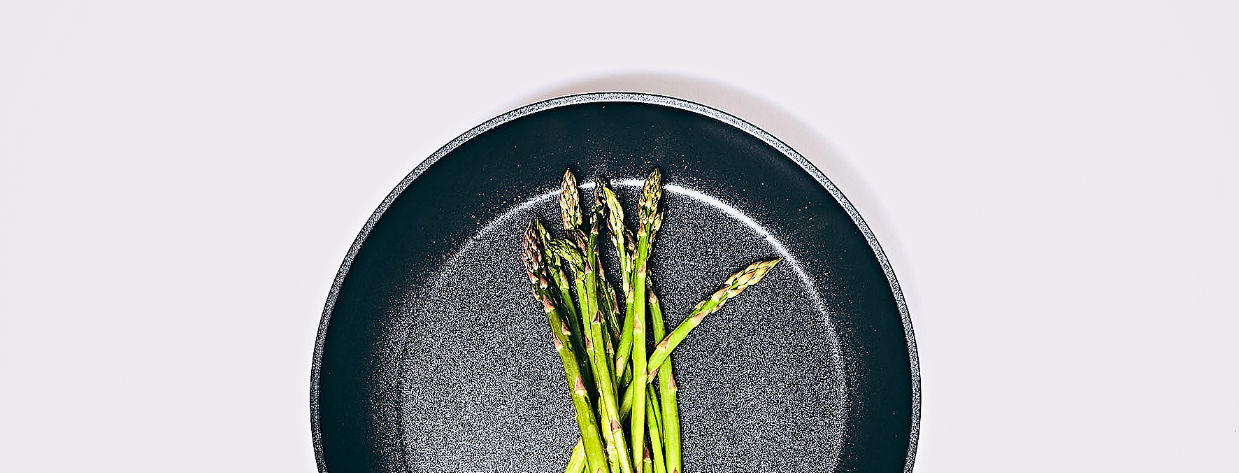
Aluminum
Aluminum is the most commonly used material for cookware (in particular, saucepans and frying pans) and offers many advantages for everyday cooking. Aluminum is an excellent conductor and allows for quick heating and uniform heat distribution. Extremely lightweight, it is also easy to handle.
All aluminum cookware is always made with a coating. Aluminum should never come into direct contact with food.
Strong points
- Lightweight: extremely lightweight, aluminum cookware is easy to handle and clean.
- Conductivity: heat is distributed quickly and evenly across the entire saucepan or frying pan.
- Cooking: thanks to its non-stick coating, aluminum cookware requires no (or very little) fat such as oil or butter during cooking.
- Maintenance: the non-stick coating makes the cookware extremely easy to clean. For more information on cleaning and maintaining you cookware, please see our "Tips" page.
- Price: in general, aluminum cookware is inexpensive.
Weak points
- Lifespan: even the most resistant coatings deteriorate over time. Aluminum cookware must therefore be replaced fairly regularly (on average, every 2 to 3 years).
- Compatibility: without a special base, aluminum cookware cannot be used on induction cooktops.
- Cooking: aluminum cookware cannot be used over high heat as this can damage its coating. The material is therefore not suitable for recipes that call for extremely high cooking temperatures.
Sitram offers several lines of aluminum cookware. Pressed aluminum cookware is lightweight and an excellent conductor of heat. Forged aluminum cookware is more robust and has a thicker base. And cast aluminum cookware is extremely durable thanks to its reinforced body. All our aluminum cookware comes with an integrated or detachable handle. The latter saves you precious kitchen space and facilitates the removal of hot pans from the oven.
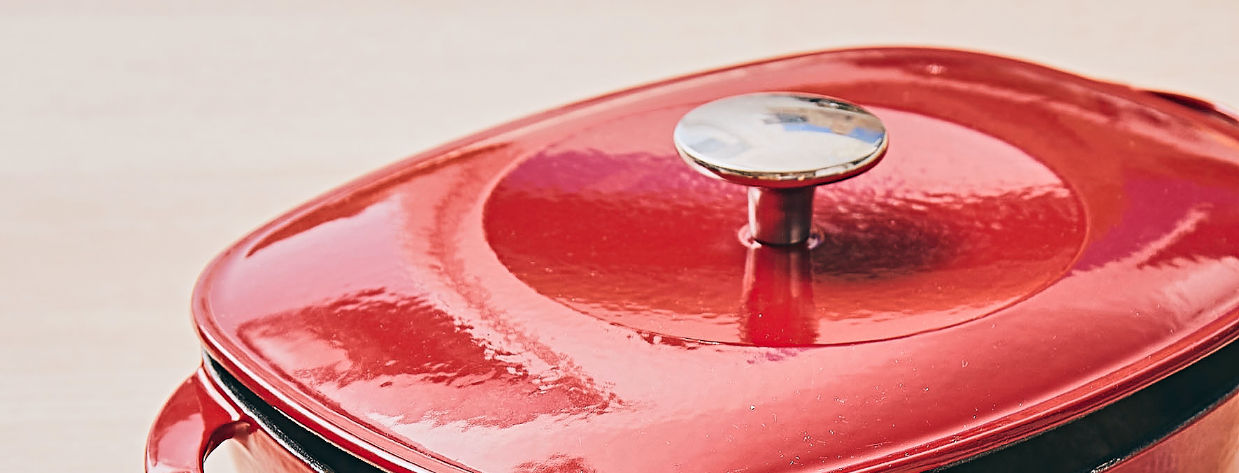
Cast iron
Cast iron cookware is mostly used by professionals. However, the material also presents many advantages for non-professional users. An alloy of iron and carbon, cast iron is extremely robust and durable. Cast iron cookware retains heat and is therefore perfect for simmering foods. You can also use it over high heat.
Sitram's famous Dutch ovens are made of cast iron. Extremely versatile, our Dutch ovens can be used to cook foods over low heat on all types of cooktops. They can even be used in the oven. Our enameled cast iron Dutch ovens are incredibly resistant. The enamel protects the cast iron from oxidation (and rust) and makes it easy to clean.
Strong points
- Solid: natural cast iron can withstand extreme differences in temperature and metal utensils.
- Durable: cast iron Dutch ovens can be passed down to future generations.
- Cooking: heat is distributed evenly and the cookware can be used over high heat. Cast iron cookware is ideal for recipes calling for long, slow cooking times and retains heat extremely well.
- Healthy: cast iron cookware contains no toxic products.
Weak points
- Weight: the main weakness of cast iron is its heavy weight (which by the way gave rise to the famous expression "pumping iron").
- Cooking: cast iron takes longer to heat than other materials. It also requires fat (e.g., oil or butter) for cooking (nevertheless, with use, cast iron cookware develops its own, natural non-stick coating. For this reason, it is often recommended that you refrain from using detergents to clean your cast iron cookware).
Steel and other materials
Sitram mainly offers aluminum, cast iron, and stainless steel cookware. However, other materials are sometimes used to make cookware, even if these materials are usually less effective. Made of iron, steel cookware is left raw and uncoated. Lightweight and affordable, steel is also an excellent conductor and distributor of heat. Ceramic is ideal for natural and healthy cooking but breaks easily. Copper saucepans and frying pans are also fragile, as well as quite expensive.
Other cookware and kitchen accessories are made of silicone (e.g., silicone molds for the easy removal of cakes), glass (in particular, serving dishes), or plastic (only those recipes that do not call for heating).
Sitram triple-layer
bodies and bases
Sitram offers premium cookware in a variety of different materials to meet all your cooking needs. Some of our cookware comes with a triple-layer body or base to withstand extreme differences in temperatures and provide for optimal heat distribution (and thus homogeneous cooking).
Triple-layer base
Our triple-layer base is composed of three distinct layers:
- the body of the cookware;
- an aluminum disk;
- an outer shell done in stainless steel.
A layer is welded to the bottom of the cookware to provide for increased protection against extreme differences in temperatures (i.e., a thermal buffer), and improve the distribution of heat (thanks to the conductivity of the aluminum). The outer shell makes the cookware compatible with induction cooktops. The thicker the triple-layer base, the more robust and durable the product is over time.
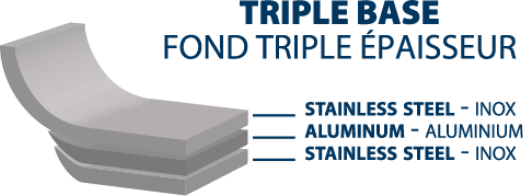
Triple-layer body
Here, the entire body of the cookware is made of a combination of three robust materials:
- professional quality stainless steel on the inside;
- aluminum in the middle;
- induction-compatible stainless steel on the outside.
The thickness of the entire cookware (body and base) is uniform for even greater durability. A layer of aluminum between the two layers of stainless steel provides for the homogeneous distribution of heat. This type of cookware is extremely resistant to differences in temperatures and warping.
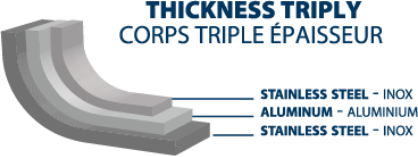
You will find our cookware in most retail shops, as well as general or specialized stores on the Internet!
